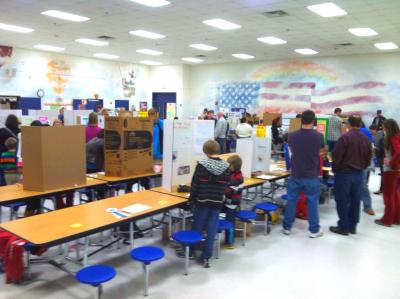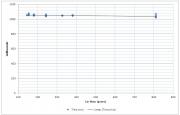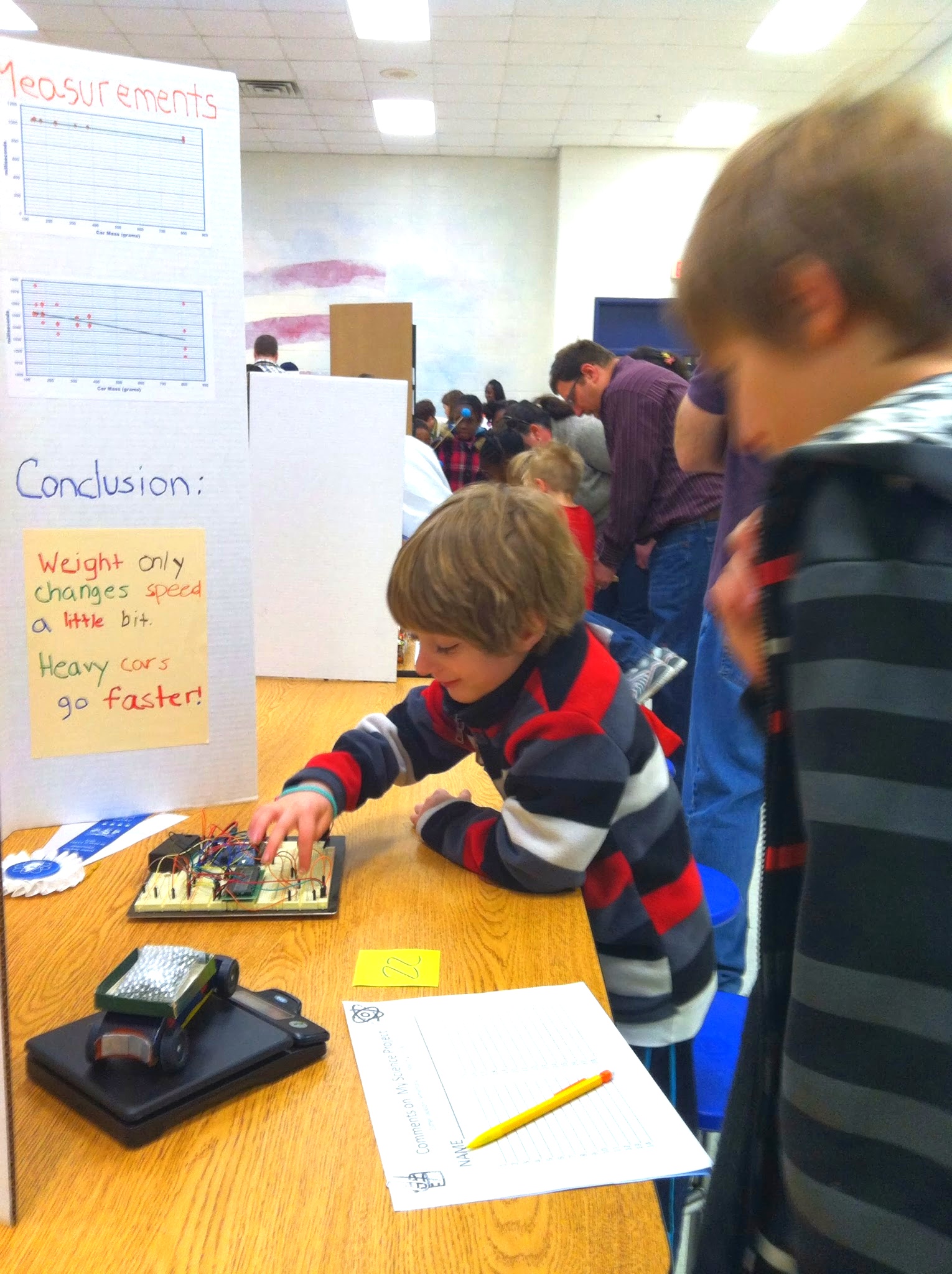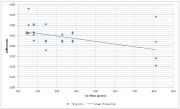Report from the Science Expo
Primary tabs
To get ready for the science expo, I wired the timer to the track in a semi-permanent way, then I helped Liam run a series of timing runs on the track. This was my opportunity to walk through the scientific method with him. It was a bit tricky to do it in a way that a second grader can understand. For instance, although Liam is in an advanced math program, he is only now starting to work on the concepts of fractions. Decimals are not even on the horizon yet. So I needed to figure out a way that he could report all of the results in whole numbers. This did require me to explain the idea of milliseconds, but he got that readily enough. So we measured the mass of the car in grams, and the times in milliseconds. He had no trouble seeing 1.042 seconds and writing down 1042 ms.
 We did five runs of the car at each mass. For the mass variable, I mounted a small box lid on the top of his car. Luckily, his car design has a flat top. This way, we were able to change the mass of the vehicle without significantly changing the aerodynamic cross section of the car as it travels down the track. I didn't expect him to understand the various complexities of what is actually going on to determine the time of the car, from rolling friction to air resistance to potential and kinetic energy. Nor did we go into Galileo and the Newtonian laws of motion. Keeping his attention on this for even 20 minutes at a time over several sessions was hard enough. I just asked him for his hypothesis. Would a light car go faster or slower than a heavier car? He thought a lighter car would go faster. So that's where we started.
We did five runs of the car at each mass. For the mass variable, I mounted a small box lid on the top of his car. Luckily, his car design has a flat top. This way, we were able to change the mass of the vehicle without significantly changing the aerodynamic cross section of the car as it travels down the track. I didn't expect him to understand the various complexities of what is actually going on to determine the time of the car, from rolling friction to air resistance to potential and kinetic energy. Nor did we go into Galileo and the Newtonian laws of motion. Keeping his attention on this for even 20 minutes at a time over several sessions was hard enough. I just asked him for his hypothesis. Would a light car go faster or slower than a heavier car? He thought a lighter car would go faster. So that's where we started.
I did get the idea into him that we needed to make multiple measurements, because with real world testing, little things can change the results. We ran the car five times at each mass. We used a little baggie filled with BB's as the additional weight. It fit into the box lid on top of the car and with it we could eventually almost double the mass of the car. I did cheat a bit and do one test with a really heavy weight on top, to quadrupal the mass of the system just so we could increase the mass range. We had also borrowed his cousin Aidan's Pinewood Derby car, and I was planning to run that one on the track as well. Especially since it has a much more streamlined shape. But after our initial data, and the difficulty of keeping him focused on things, I decided that one data set was good enough for a seven year old. We didn't need to deal with the variability of differing aerodynamic shapes. Maybe a future experiment . . .
On the night before the expo, his mother and I helped Liam put together a display board. I showed him how we could add the numbers into a simple spreadsheet, and I helped him understand a couple of charts. I printed them out and he attached them to the board.
 On Thursday, Liam and I went to the science expo at his elementary school. It was held in the cafeteria, and included all of the kids who had applied for the expo in all five grades at the school. Here, you can see Liam with his setup at one of the tables. It eventually got much more crowded. I think Liam had a good time. Other kids and their parents occasionally came up and asked questions. I tried to get out of the way and let Liam do the talking. He didn't have a problem and explained the setup to quite a few kids and even a few grownups. He and some other kids had some fun running the car down the track with the weight packet on top. That was more an example of the conservation of momentum and inertia, as the packet always went flying as the car stopped at the bottom each time. After about two hours, the organizers thanked everyone and we all went home. Everyone got a paricipation certificate and a nice blue and white ribbon.
On Thursday, Liam and I went to the science expo at his elementary school. It was held in the cafeteria, and included all of the kids who had applied for the expo in all five grades at the school. Here, you can see Liam with his setup at one of the tables. It eventually got much more crowded. I think Liam had a good time. Other kids and their parents occasionally came up and asked questions. I tried to get out of the way and let Liam do the talking. He didn't have a problem and explained the setup to quite a few kids and even a few grownups. He and some other kids had some fun running the car down the track with the weight packet on top. That was more an example of the conservation of momentum and inertia, as the packet always went flying as the car stopped at the bottom each time. After about two hours, the organizers thanked everyone and we all went home. Everyone got a paricipation certificate and a nice blue and white ribbon.
 If you're curious about the results. I'm attaching them here. I've also uploaded the spreadsheet of the data below. It's a small set of data, but it probably shows a realistic assessment of the situation. As you would expect, mostly it doesn't matter. Over this short distance and relatively slow speeds, friction and wind resistance are negligible, so the times are pretty much identical no matter the mass of the vehicle. We did see a slight increase in the speed as the car got much heavier, presumably because the pull of gravity got much more forceful in overcoming a very small rolling friction. I plotted the chart two ways: the first at the full time scale (0 to 1.2 seconds) and the second a 'zoom in' on the data showing the variation since all of the timing results were actually in a very small range between 1.000 and 1.100 seconds.
If you're curious about the results. I'm attaching them here. I've also uploaded the spreadsheet of the data below. It's a small set of data, but it probably shows a realistic assessment of the situation. As you would expect, mostly it doesn't matter. Over this short distance and relatively slow speeds, friction and wind resistance are negligible, so the times are pretty much identical no matter the mass of the vehicle. We did see a slight increase in the speed as the car got much heavier, presumably because the pull of gravity got much more forceful in overcoming a very small rolling friction. I plotted the chart two ways: the first at the full time scale (0 to 1.2 seconds) and the second a 'zoom in' on the data showing the variation since all of the timing results were actually in a very small range between 1.000 and 1.100 seconds.

